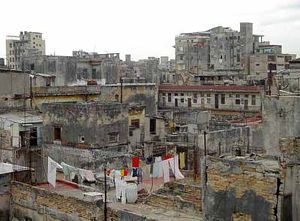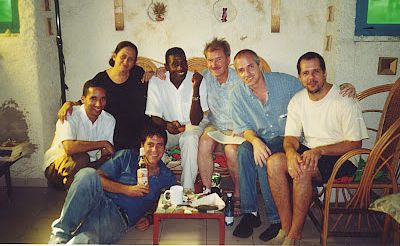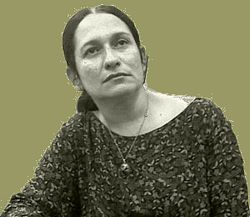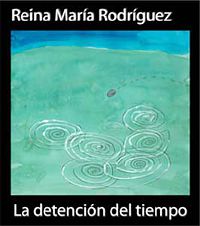
Cuba’s Young Poets(1)
Elizabeth Hanly
 Nearly every evening at dusk a group of young poets gathers together to talk and work in the living room of a small house built on a flat rooftop in Havana. From here you can see much of the broken filigree of what may still be the most graceful city in the world. Havana was made for pleasure, first as an R & R capital for the treasure ships of the Spanish Empire, then later as a tropical Paris during the sugar boom delirium at the turn of the century.
Nearly every evening at dusk a group of young poets gathers together to talk and work in the living room of a small house built on a flat rooftop in Havana. From here you can see much of the broken filigree of what may still be the most graceful city in the world. Havana was made for pleasure, first as an R & R capital for the treasure ships of the Spanish Empire, then later as a tropical Paris during the sugar boom delirium at the turn of the century.
From here you can see the food lines that criss-cross the neighborhood as hunger becomes real on the island and the revolution wrestles with its claims of “socialist legality.” Ordinarily at dusk everybody in Havana reaches out for one another. These days the chatter and romance continue. But that effervescence now verges on hysteria. There’s talk of civil war. One of the young poets on the roof turns from the scene below. “If at this juncture,” he observes, “we don’t try to find out what it really means to be Cuban, we’re lost.”
It is another poet, who seems only a few years older than the rest, who brought this group together. It is her white—washed cottage, which she and her lover managed to build for themselves on that Havana rooftop, breaking just about all of the city’s housing laws, that everybody calls home. That home has become a legend on the isle.
Perhaps not surprisingly, considering how difficult it is for American scholars and critics to travel to Cuba, let alone get past its official culture, Reina María Rodríguez is hardly a well—known figure in the United States. Those who do know her work and her rooftop, John Beverly of the University of Pittsburgh for instance, describe her as “a key figure in the emerging post—Soviet Cuba.”
After nearly twenty—five years of a national literature so compromised that much important Cuban writing has been done in exile —the work of Reinaldo Arenas, for example —Reina María Rodríguez and the young poets on her rooftop may finally be turning that around. Several of this group have won important prizes in Spain and Mexico, others have been published in journals as prestigious as Octavio Paz’s Vuelta. And now, arguably the most authentic movement in letters seen on this island in decades is forging the way for the first legally autonomous cultural association since the revolution. A small publishing imprint will be included within its mandate. Reina —nobody ever calls her anything else —will have broken the state’s monopoly on Cuban letters.
Not even someone born to Cuban bureaucracy could have imagined the Kafkaesque circlings she’s made over the last five years to bring this project so far. Its brand—new standing may well be reversed as tensions between vying political factions continue to be played out over the group’s status. An internationally recognized Cuban intellectual described to me “a virtual terror on the part of hard-liners to allow any space for a civil society to grow.” Yet these days, considering Cuba’s economy, pragmatism is often replacing ideology.
Predictably it has been the young who have pushed the state this far. Yet it would be rather ironic if the state were to lose its hold on Cuban publishing to this group of young poets. It would be an eloquent illustration of what, in less extreme circumstances, would be theorized as art’s own imperative. For curiously, the work of those gathered on Reina’s roof, even the work of those who put themselves most on the line politically, very nearly ignores politics. This is a group described by one member as “most taken with ideas which abolish space and time.” Theirs is a poetry after far bigger than political game. Surely that, in addition to the idea of opened flood gates, is what hard-liners have found intolerable.
“Cuba is breaking apart,” the thirty-year-old poet and translator Omar Pérez tells me. “We’re trying to find ground zero from which we can begin again.”
After decades of socialist didactic literature, ground zero now translates into work laden with symbols and obscure philosophical references. One member of the group, Roberto Franquiz, has nearly completed a four-hundred-fifty-page anthology of the work of his generation. (It does not matter that Franquiz doesn’t expect his work to be published soon; he is prepared for posterity.) “For all the different voices,” Franquiz says, “this is one poetry, all of it wrestling with the idea of redemption. “
“The best work of young poets in Cuba today isn’t dissident poetry, nor is it likely to be,” says the thirty-five year-old poet and short story writer Rolando Sánchez Mejías. He should know. Until his expulsion from the party in the early 1990s, Mejías directed Cuba’s extensive network of talleres or writing workshops, a cultural network that enjoys international recognition. Many of the island’s young poets passed through these workshops. According to Sánchez Mejías, “Fear doesn’t begin to explain the current direction of poetry among the young in Cuba.”
poet and short story writer Rolando Sánchez Mejías. He should know. Until his expulsion from the party in the early 1990s, Mejías directed Cuba’s extensive network of talleres or writing workshops, a cultural network that enjoys international recognition. Many of the island’s young poets passed through these workshops. According to Sánchez Mejías, “Fear doesn’t begin to explain the current direction of poetry among the young in Cuba.”
Cultural repression certainly exists here. PEN estimates that as many as thirty Cuban writers have been imprisoned since the revolution —nearly all of them for political activities.
Castro’s regime usually saved its punch for its real or imagined political and terrorist foes. The ideological deviation of writers was most often answered with the loss of employment and restrictions pertaining to travel and access to cultural networks, and most of Cuba’s young poets are already plenty marginalized.
“When politics have come too close for too long,” Sánchez Mejías says: “when they have encroached on the most intimate details of daily life, and even on the body itself, small wonder we have this writing which tries to shake itself free of politics.”
Nearly every member of this new literary generation regards Jose Lezama Lima as a spiritual father. One of Latin America’s literary giants, Lezama was Cuba’s most enigmatic writer, the island’s James Joyce. He died in 1976, scorned by the revolution for his political apathy as well as his homosexuality. He is an apt model for the poets of this generation who are searching for what Lezama, in his monumental novel Paradiso,called “the thickening of the ectoplasm, the bone that will endure for the Resurrection.”
According to Antonio Ponte, “The task this generation has set for itself is to try to pin down an island born out of so much imagination that imagination can no longer describe, let alone contain it. That is our dilemma,” he says, “and perhaps, Cuba’s tragedy.”
Reina María Rodríguez never intended to become the center of any group, much less the focus of the current watershed political decision. While other writers of her generation were filling cultural posts in leading institutions in Havana, Reina let officialdom go its way. She wanted time to write. Supporting herself with some radio and television work, she made that time. Reina set out to catch “the language of the intimate,” those small moments which she felt were already being lost to ideology by the early 1970s.
 It would take Cuban culture nearly a decade to conclude the debate on the worthiness of “the language of the intimate” fueled by her poetry. By then, Reina had left behind what Sánchez Mejías has described as her “lyrical, highly accessible verse.” In his opinion, “She’s been one of the very few of her generation able in her work to let go of the fiction of Cuba’s brave new world and flesh out her own symbols. The strength to do so,” he believes, “came from her association with the young.”
It would take Cuban culture nearly a decade to conclude the debate on the worthiness of “the language of the intimate” fueled by her poetry. By then, Reina had left behind what Sánchez Mejías has described as her “lyrical, highly accessible verse.” In his opinion, “She’s been one of the very few of her generation able in her work to let go of the fiction of Cuba’s brave new world and flesh out her own symbols. The strength to do so,” he believes, “came from her association with the young.”
One by one, the most committed and driven of the young began to congregate on Reina’s rooftop. Artists and writers shower here, when there is no water at home. They study and write here when there is no electricity at home. When writers like Omar Pérez aren’t able to read publicly anywhere else, they read on her “patio.” If anyone locates some extra food, they bring it here.
In her rattan rocking chair, fast-talking Reina rocks at a clip. Small, slight, and hawk-eyed, she’s given to sudden shyness. “There seem to be short bursts of poetry in Cuba,” she says. “One centered around Lezama and his magazine Orígenes in the forties and fifties. Something similar is happening now.”
At dusk, taciturn, round-shouldered Rogelio Saunders is often at Reina’s. Home from the war in Angola(2) and working as a night watchman, he is fascinated by the postmodern style. His work is full of Wittgenstein. “Perhaps we are not able to see God because we can’t see the light with which we see,” he writes. Amelio(3) Calderón Fornaris is here too. Short and disheveled, the librarian and science-fiction fanatic is too shy to say much in front of others, but his poetry is full of mad somersaults. “In some way I need to bite a star ... an aleph ... the melody which accompanies cats when they think of hunting at night ... In some way I’ll need to bite myself ... because food hasn’t been enough,” he writes. Víctor Fowler Calzada, a rather lordly ex-secondary school-teacher, usually turns up. One of the most privileged of the group, Fowler currently edits the occasional compilation of lectures from Gabriel García Márquez’s Havana-based Film Institute. Erotica is what most fascinates this poet. “Bodies are only the pretext,” Fowler writes. “The real drama is the unease, anxiety trying to possess it all.” And silent Rito Ramón Aroche, another night watchman —his work is a Zen of love.
And there’s Sánchez Mejías, unemployed since the crown prince of the cultural establishment became regarded by several important factions as a black sheep. To support himself, Sánchez Mejías is selling flowers in the streets of Havana. Tall and bearded, articulate as he is, the writer and educator has a stammer, sometimes so severe that it costs him to speak. More of the work of this group is dedicated to him even than to Reina. “The dignity of the world,” he writes, “may consist in conserving some small bit of its ruin.”
Women are here as well. Their work tends to be less abstract and philosophical, more immediate and closely observed. The group’s youngest member, languid twenty-four year-old Alessandra Molina works at a municipal arts center and describes herself as a student of the Japanese writer Yukio Mishima, without perhaps realizing how closely her mediations resemble the work of Brazilian novelist Clarice Lispector. And twenty-seven year-old Damaris Calderón Pérez works occasionally with Cuban radio and writes with skepticism of that most Latin American of cliches —the intoxication of love —“women drunk with fear rush against the light” —but with no skepticism of a parallel intoxication of the spirit —“always at a well, I try to touch the water ... I tell you this with all the terror of a high—wire walker.”
And Reina. Once she told me “Everything in Cuba is torn between two poles. No other island may be more idealistic or more pragmatic, more romantic or more obscene, more reverent or more blasphemous.” Likewise, no one in this group is more preoccupied with loneliness and demons than Reina. No one is more apocalyptic. No one is more hopeful. And in spite of herself, she’s become a celebrity not only on her island but throughout Latin America and Europe. Her poems have been translated into six languages and published in over a dozen countries.
Much like politics, popular culture has also become suspect for many of these young poets. Cuba is so noisy, and their own work is silent. Cuba is full of wicked humor; much of their work is somber. Cubans are still deeply connected to one another. Yet Rogelio Saunders claims that “the world grows through loneliness.”
“Many of us are more concerned with memory than popular culture,” says Sánchez Mejías. “As a people we Cubans have had little respect for memory —or history. It seems we might have something to gain from developing that, no?” The language the young poets are after “rarely existed in Cuba, even before the revolution.” Sánchez Mejías is referring to a “thinking language” in which poetry meets philosophy, especially metaphysics, in the tradition of Eliot, Pound, Borges, Paz, Cortázar, and of course, Lezama Lima. As Lezama once put it, referring to a character in his Paradiso,“He knows that a day has been assigned to him in which he will be transfixed, and he will not see the fish inside the current but the fish in the starry basket of eternity.”
More than others, Antonio Ponte, a hydraulic engineer turned screenwriter, respects the island’s popular culture, particularly its Afro-Cuban faith, and incorporates its contradictions in his work. He raises unease to an art, stripping Cuban spirituality to the bone. His work is so quiet than one can begin to hear the real dynamics, usually just out of reach.
For Ponte, the divine is at hand on the island. He sees Cubans as driven by energies, gods who can appear quite capricious, certainly beyond human comprehension. “Poor humankind,” he writes, “trying to remain clean of mud, dry of rains.” He believes that “the real tragedy of Cuba isn’t so much politics or under-development. Rather, it’s impossible to live with the gods so close. Cuba suffers from an over-abundance of religious imagination.” Omar Pérez agrees, describing a Cuban compulsion “not to be different from one another but from ordinary reality.” Ponte adds. “Cubans are always trying to dance with the shadow of God,” or less romantically, “We’re given to a kind of schizophrenia, always looking over our shoulders, trying to talk to God, or to curse him. Everything is pending in Cuba. A god or hurricane may strike at any moment. The Cuban earth holds memory for its people. The island itself knows far more than we do. It pulls at us, often giving euphoria, but never any peace at all.”
“At best, many in the government are dismayed by us,” says Sánchez Mejías. “They see even our apolitical writing as amounting to a critique, but they don’t know how or what to do about it.”
Despite the constant of political repression in Cuba the revolution wasn’t always so suspicious of its poetry. “Even with their ideological skirmishes, the sixties in Cuba were a cultural Golden Age,” says Omar Pérez. “All the greats were being published: Lezama, Alejo Carpentier, Virgilio Piñera, Reinaldo Arenas.” Before the revolution created its string of publishing houses, the industry had been so limited that Cuban writers, even of the caliber of Lezama, often paid to publish their work themselves. “During that epoch the magazine of the Casa de las Américas” —a pan-cultural organization conceived by the revolution— “was the best that Cuba ever produced. But by the late 1960s it was all over. What had been, in the best sense of the word, a cultural revolution was finished. Some believe the revolution itself ended at that time.” There are those who say undercurrents destructive to Cuba’s culture were there from the start. They point to isolated cases of repression in the arts, as well as persecution of the gay community, which began as early as 1961. But unlike that of Eastern Europe and the Soviet Union, the mix of Cuban cultural life has often contained powerful competing factions. And according to Pérez, during the 1960s cultural repression was not yet revolutionary dogma.
“And the seventies?” Pérez is unequivocal. “The seventies were the lead years.” In 1971, after a four year cat-and-mouse game, the poet Herberto Padilla was jailed for over a month. No one in the Writers’ Union had gone further in public criticism of what was fast becoming the “state literature” in Cuba. His poems satirized the ambience that permitted it, an ambience that had begun to permeate the island. “One step forward,” he writes “and two or three backwards: but always applauding.” The titles of a 1968 volume of poetry and one from 1971 spell out his position: Out of the Came and Provocations. Yet Out of the Game won the annual Writers’ Union competition in 1968. And three years later, when Padilla read excerpts from the yet to be published Provocations, the Writers’ Union audience was enthusiastic. Clearly there were those who saw Padilla’s poems not as counter-revolutionary but as cautionary: welcome additions to the debate on the role of the arts within the society they hoped to create.
game, the poet Herberto Padilla was jailed for over a month. No one in the Writers’ Union had gone further in public criticism of what was fast becoming the “state literature” in Cuba. His poems satirized the ambience that permitted it, an ambience that had begun to permeate the island. “One step forward,” he writes “and two or three backwards: but always applauding.” The titles of a 1968 volume of poetry and one from 1971 spell out his position: Out of the Came and Provocations. Yet Out of the Game won the annual Writers’ Union competition in 1968. And three years later, when Padilla read excerpts from the yet to be published Provocations, the Writers’ Union audience was enthusiastic. Clearly there were those who saw Padilla’s poems not as counter-revolutionary but as cautionary: welcome additions to the debate on the role of the arts within the society they hoped to create.
Two months after that reading, Padilla was arrested. Upon his release the Writer’s Union presented an evening of self-confession featuring Padilla and four other writers. He spent nine more years in Cuba, largely shunned by fellow writers, and unable to publish. Finally, he was able to leave the island for the United States in 1980. Some cultural historians claim his elaborate mea culpa alerted the international community to what had become, at least for a time, the neo-Stalinization of Cuba. But on the island, the Padilla affair, as it came to be called, inaugurated an unprecedented period of self-censorship. Cuba has yet to recover.
During the 1970s, Virgilio Piñera and Jose Lezama Lima tried to go on as before, but none of their late work was published in Cuba during their lifetimes. (Both died on the island late in the decade.) A few important poets, like Eliseo Diego and Dulce María Loynaz (who in 1992, at the age of ninety, received Spain’s prestigious Cervantes Award) did manage to stay on the island and away from officialista writings, but they were the exceptions. During this period the work of major international figures such as Borges and the Spanish philosopher Jose Ortega y Gassett were banned in Cuba. “During those years,” says Sánchez Mejías, “the Ministry of Culture published and published —but what they were trying to create still fell apart.”
“The 1980s were to be a return to the 1960s —that was the hype,” says Omar Pérez. “Everyone was supposed to be able to publish and travel.” “During most of the decade,” insists Reina, “the Ministry of Culture did try to support Cuban artists.” Many of the young poets agree, even if some see that support as political expediency. Indeed, the decade is full of stories of highly placed Cultural Ministry officials forced to sign on for the so-called “pajama plan” (instant retirement), after agreeing to certain readings and exhibitions. In perhaps the most notorious case, at an art opening in 1989, a young painter gave performance art a new twist by defecating on a copy of Granma, the Party newspaper, in the middle of his show. He was sentenced to six months in jail.
“Far more than the 1970s, the 1980s brought out the deep contradictions of the revolution,” says Pérez. “The powers that be in Cuba so love talent, they’re obsessed by it,” says a poet who prefers to remain anonymous. “The institutions of the regime have done a great deal to foster it. They nurture the young —until of course the young outgrow the space the revolution intended for them to have. They start making demands; those demands are read as political; then the trouble starts. It’s happened here over and over.”
Pérez points to Paideia as a case in point. A de facto organization named for a Greek cultural ideal, “Paideia came together in the late 1980s as young artists of every discipline sought an alternative to official discourse,” says Sánchez Mejías. Within eighteen months, most of Paideia’s leaders were black-balled. Others quietly joined what was a veritable, and certainly government-sanctioned, diaspora of young artists from the isle in 1989-1990. Periodicals such as Caiman Barbudo (Bearded Alligator) and Naranja Dulce (Sweet Orange) —a magazine created by young poets Víctor Fowler and Omar Pérez —which showcased the work of the young and employed several members of Paideia, were closed.
One wonders why the state ever allowed Reina’s group to become so strong. “It couldn’t have happened in the 1970s,” says one of the young poets. “By the time the revolution swung conservative again in the late 1980s Reina’s reputation was international.” “For a long time the powers that be underestimated the independence of her will. She was considered a charming eccentric, good for promotion of the revolution’s tolerance,” added a young painter. “Besides,” added another young poet, “the revolution has often shown itself astute in not harming those they regard as safety valves.” And in trying to contain the chaos of the nineties, the state moves carefully —not to inflame, but to contain.
What sort of future would these poets choose for themselves? “It’s hard to say,” answered Antonio Ponte. “Ideas are changing too quickly.” One of the group, long silent, spoke up now. “The revolution wasn’t just repression,” he said. “Under Fidel, those in the countryside became people instead of animals.” The poet paused. “We all fought to be Ché Guevara when we played together as children. Yet the asceticism of Ché and the Party attacked the grace at the very heart of Cuba, especially the Cuba of the cities. What makes it all sadder is that the grace had been available to a substantial proportion of the population.” Still the work of the majority of these young poets is full of a quiet romance with the ideals of the revolution, mid-sixties style. The feeling that something was cut short, unrealized, may well haunt Cuba in the future.
And as always, Miami looms on the horizon. One poet refers to the two groups, Cubans on the island and those in exile, as “two sets of lab rats, engaged in what was always, on both sides, too savage an experiment in economics and culture.” At some point surely those two groups will meet. (Already there are exiles with blueprints for shopping malls in colonial Havana.) And what happens then, after the initial euphoria?
All this may be years away, despite the near-hysteria everywhere. For as Sánchez Mejías puts it, “We who live here have a sense of how long things take. Nothing is about to happen.”
For now, Reina, who never set out to be heroic, continues her fight for autonomous culture. But the future of Reina’s House of Poetry may be much less important that her open home, where the young have gathered now for so many years. And tonight, like all other nights, Reina tosses her keys from the roof to the young artists calling to her from below.
Notas
1. Partisan Review, 1-1996 VOL. LXIII No. 1. Publicado originalmente en The Guardian Unlimited el 21 de agosto de 1994, bajo el título “Revolutionary fight for youth’s poetic licence”.
2. Error de Hanly. El país era Etiopía, y la situación (entre 1982 y 1984), la de una paz armada, con ataques y escaramuzas esporádicos, que culminaron en una verdadera situación de guerra (y una incipiente hambruna) en 1984.

